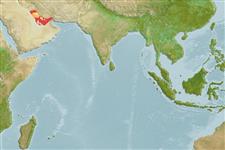Actinopterygii (ray-finned fishes) >
Clupeiformes (Herrings) >
Clupeidae (Herrings, shads, sardines, menhadens) > Dorosomatinae
Etymology: Herklotsichthys: After Janus Adrian Herklots, Australian ichthyologist, 1820-1872.
Environment / Climate / Range
Ecology
Marine; pelagic-neritic; depth range 0 - 50 m (Ref. 188). Subtropical, preferred ?; 31°N - 24°N, 47°E - 57°E (Ref. 188)
Western Indian Ocean: Persian Gulf, possibly also the Red Sea.
Size / Weight / Age
Maturity: Lm ? range ? - ? cm
Max length : 8.0 cm SL male/unsexed; (Ref. 188); common length : 7.0 cm SL male/unsexed; (Ref. 188)
Dorsal
spines
(total): 0;
Dorsal
soft rays
(total): 13-21;
Anal
spines: 0;
Anal
soft rays: 12 - 23. Closely resembles H. punctatus in shape, but the latter lacks a dark blotch on the dorsal fin and has small dark spots along the back and not on the flank. Distinguished from H. spilurus by its more slender body and spots along the flank. Possibly overlaps range of H. quadrimaculatus, which lacks spots on the flank and has elongate wing-like scales underneath paired pre-dorsal scales.
A schooling species found in coastal waters. Coastal pelagic (Ref. 68964).
Life cycle and mating behavior
Maturity | Reproduction | Spawning | Eggs | Fecundity | Larvae
Whitehead, P.J.P., 1985. FAO Species Catalogue. Vol. 7. Clupeoid fishes of the world (suborder Clupeioidei). An annotated and illustrated catalogue of the herrings, sardines, pilchards, sprats, shads, anchovies and wolf-herrings. FAO Fish. Synop. 125(7/1):1-303. Rome: FAO. (Ref. 188)
IUCN Red List Status (Ref. 115185)
CITES (Ref. 94142)
Not Evaluated
Threat to humans
Harmless
Human uses
Fisheries: of potential interest
More information
ReferencesAquacultureAquaculture profileStrainsGeneticsAllele frequenciesHeritabilityDiseasesProcessingMass conversion
Tools
Special reports
Download XML
Internet sources
